engine FIAT IDEA 2007 1.G Repair Manual
[x] Cancel search | Manufacturer: FIAT, Model Year: 2007, Model line: IDEA, Model: FIAT IDEA 2007 1.GPages: 314, PDF Size: 4.78 MB
Page 252 of 314
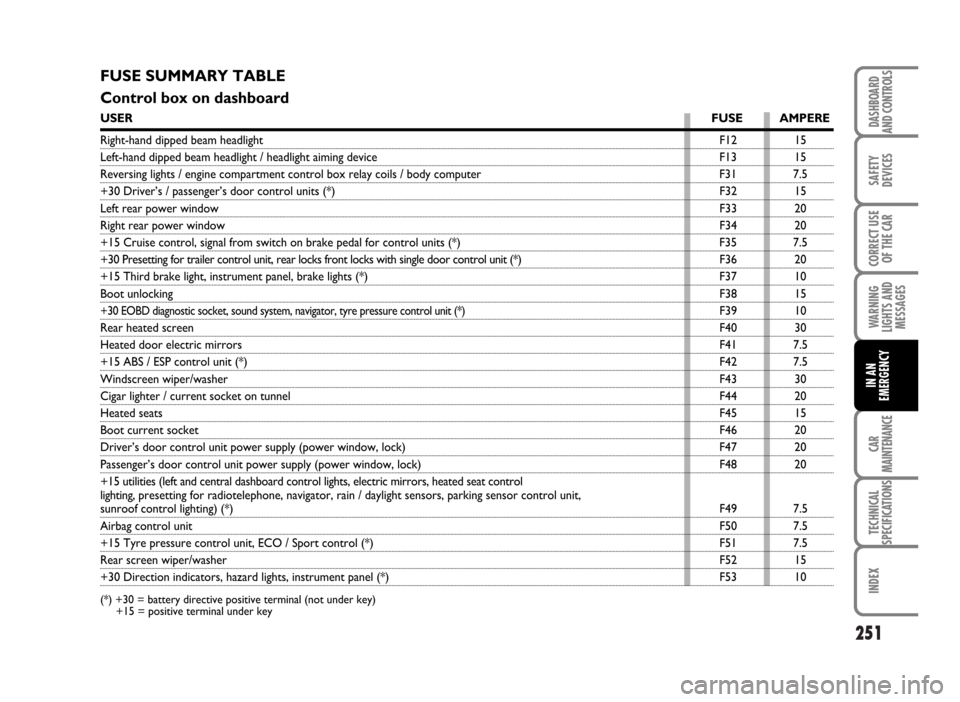
251
SAFETY
DEVICES
CORRECT USE
OF THE CAR
WARNING
LIGHTS AND
MESSAGES
CAR
MAINTENANCE
TECHNICAL
SPECIFICATIONS
INDEX
DASHBOARD
AND CONTROLS
IN AN
EMERGENCY
FUSE SUMMARY TABLE
Control box on dashboard
USERFUSE AMPERE
Right-hand dipped beam headlightF12 15
Left-hand dipped beam headlight / headlight aiming device F13 15
Reversing lights / engine compartment control box relay coils / body computer F31 7.5
+30 Driver’s / passenger’s door control units (*)F32 15
Left rear power windowF33 20
Right rear power windowF34 20
+15 Cruise control, signal from switch on brake pedal for control units (*) F35 7.5
+30 Presetting for trailer control unit, rear locks front locks with single door control unit (*) F36 20
+15 Third brake light, instrument panel, brake lights (*) F37 10
Boot unlockingF38 15
+30 EOBD diagnostic socket, sound system, navigator, tyre pressure control unit (*)F39 10
Rear heated screenF40 30
Heated door electric mirrorsF41 7.5
+15 ABS / ESP control unit (*)F42 7.5
Windscreen wiper/washerF43 30
Cigar lighter / current socket on tunnelF44 20
Heated seatsF45 15
Boot current socketF46 20
Driver’s door control unit power supply (power window, lock) F47 20
Passenger’s door control unit power supply (power window, lock) F48 20
+15 utilities (left and central dashboard control lights, electric mirrors, heated seat control
lighting,presetting for radiotelephone, navigator, rain / daylight sensors, parking sensor control unit,
sunroof control lighting) (*)F49 7.5
Airbag control unitF50 7.5
+15 Tyre pressure control unit, ECO / Sport control (*) F51 7.5
Rear screen wiper/washerF52 15
+30 Direction indicators, hazard lights, instrument panel (*) F53 10
(*) +30 = battery directive positive terminal (not under key)
+15 = positive terminal under key
Page 253 of 314
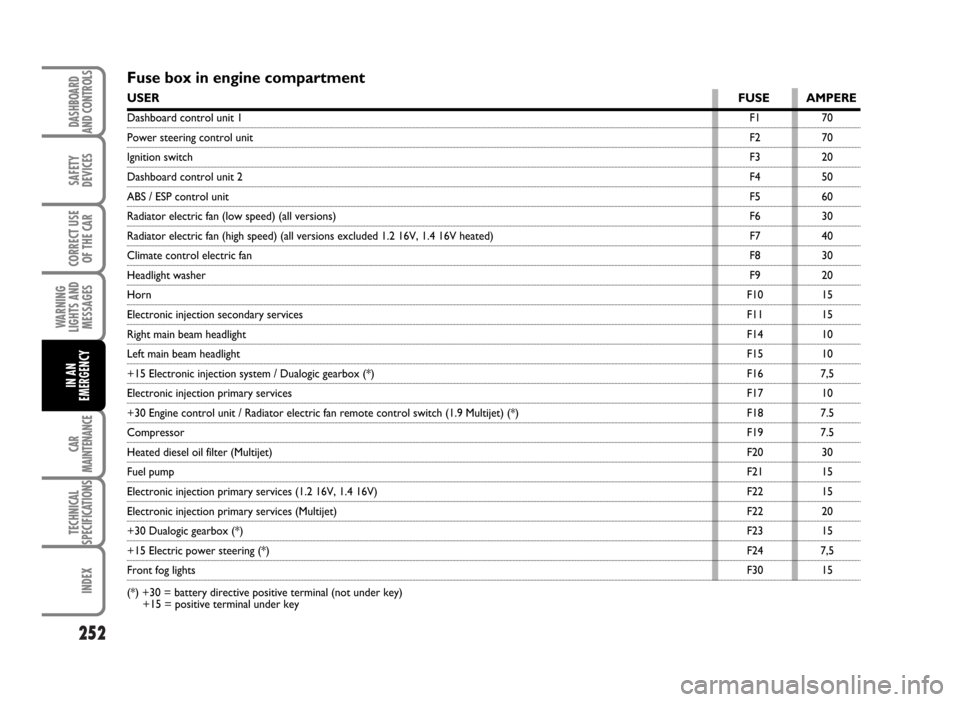
252
SAFETY
DEVICES
CORRECT USE
OF THE CAR
WARNING
LIGHTS AND
MESSAGES
CAR
MAINTENANCE
TECHNICAL
SPECIFICATIONS
INDEX
DASHBOARD
AND CONTROLS
IN AN
EMERGENCY
Fuse box in engine compartment
USERFUSE AMPERE
Dashboard control unit 1F1 70
Power steering control unitF2 70
Ignition switchF3 20
Dashboard control unit 2F4 50
ABS / ESP control unitF5 60
Radiator electric fan (low speed) (all versions)F6 30
Radiator electric fan (high speed) (all versions excluded 1.2 16V, 1.4 16V heated) F7 40
Climate control electric fanF8 30
Headlight washerF9 20
HornF10 15
Electronic injection secondary servicesF11 15
Right main beam headlightF14 10
Left main beam headlightF15 10
+15 Electronic injection system / Dualogic gearbox (*)F16 7,5
Electronic injection primary servicesF17 10
+30 Engine control unit / Radiator electric fan remote control switch (1.9 Multijet) (*) F18 7.5
CompressorF19 7.5
Heated diesel oil filter (Multijet)F20 30
Fuel pumpF21 15
Electronic injection primary services (1.2 16V, 1.4 16V)F22 15
Electronic injection primary services (Multijet)F22 20
+30 Dualogic gearbox (*)F23 15
+15 Electric power steering (*)F24 7,5
Front fog lightsF30 15
(*) +30 = battery directive positive terminal (not under key)
+15 = positive terminal under key
Page 254 of 314
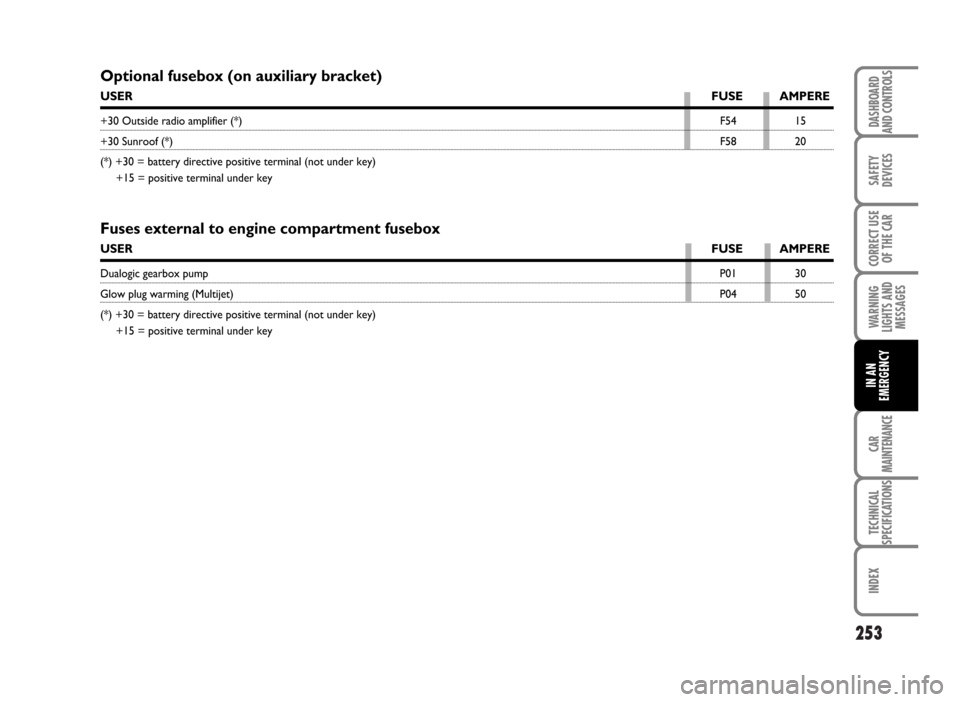
253
SAFETY
DEVICES
CORRECT USE
OF THE CAR
WARNING
LIGHTS AND
MESSAGES
CAR
MAINTENANCE
TECHNICAL
SPECIFICATIONS
INDEX
DASHBOARD
AND CONTROLS
IN AN
EMERGENCY
Fuses external to engine compartment fusebox
USERFUSE AMPERE
Dualogic gearbox pumpP01 30
Glow plug warming (Multijet)P04 50
(*) +30 = battery directive positive terminal (not under key)
+15 = positive terminal under key
Optional fusebox (on auxiliary bracket)
USERFUSE AMPERE
+30 Outside radio amplifier (*)F54 15
+30 Sunroof (*)F58 20
(*) +30 = battery directive positive terminal (not under key)
+15 = positive terminal under key
Page 258 of 314

257
SAFETY
DEVICES
CORRECT USE
OF THE CAR
WARNING
LIGHTS AND
MESSAGES
CAR
MAINTENANCE
TECHNICAL
SPECIFICATIONS
INDEX
DASHBOARD
AND CONTROLS
IN AN
EMERGENCY
WARNING
WARNING
Do not start the engine when towing the car.
WARNINGWhile the car is being towed with the
engine off, remember that the brake
pedal and steering will require more
effort as you no longer have the benefit
of the brake booster and the electrical
power steering. Do not use flexible cables
to tow. Avoid jerking. Whilst towing,
ensure that the coupling to the car does
not damage the surrounding components.
When towing the car, you must comply
with the specific traffic regulations
regarding the tow hitch and how to tow
on the road. TOW RING HOOKING
Proceed as follows:
❒take the tow ring (B) from its support;
❒tighten the ring on the rear or front threaded pin.
F0H0204m
F0H0205m
Before starting to tow, turn the ignition
key to MAR and then to STOP. Do not
remove the key. If the key is removed, the
steering lock engages automatically which
prevents the wheels being turned.
Page 261 of 314
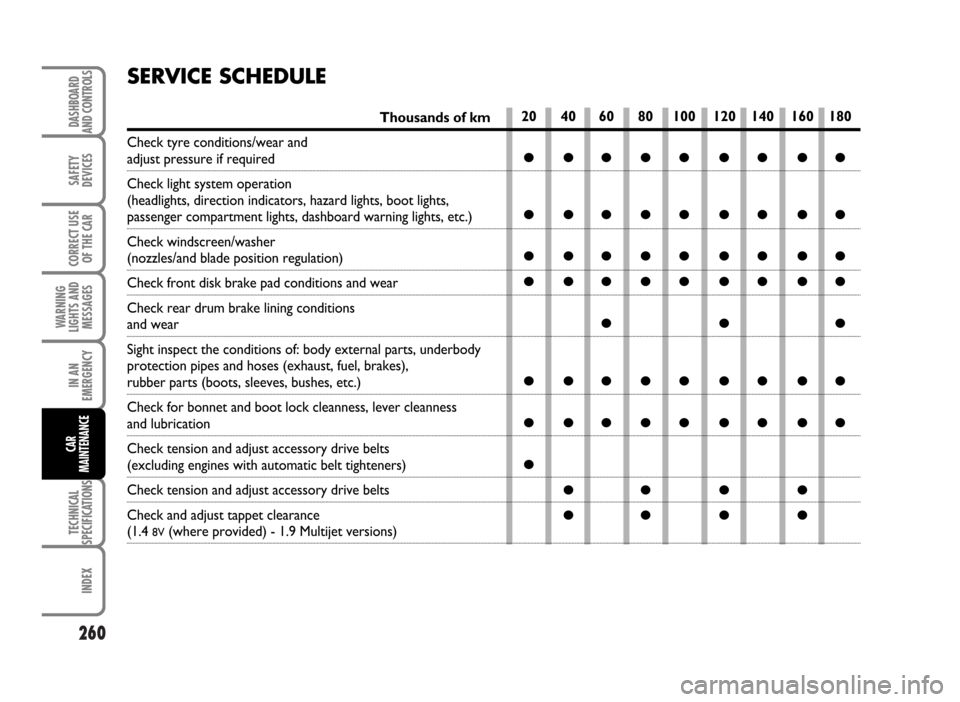
260
SAFETY
DEVICES
CORRECT USE
OF THE CAR
WARNING
LIGHTS AND
MESSAGES
IN AN
EMERGENCY
TECHNICAL
SPECIFICATIONS
INDEX
DASHBOARD
AND CONTROLS
CAR
MAINTENANCE
SERVICE SCHEDULE
Thousands of km
Check tyre conditions/wear and
adjust pressure if required
Check light system operation
(headlights, direction indicators, hazard lights, boot lights,
passenger compartment lights, dashboard warning lights, etc.)
Check windscreen/washer
(nozzles/and blade position regulation)
Check front disk brake pad conditions and wear
Check rear drum brake lining conditions
and wear
Sight inspect the conditions of: body external parts, underbody
protection pipes and hoses (exhaust, fuel, brakes),
rubber parts (boots, sleeves, bushes, etc.)
Check for bonnet and boot lock cleanness, lever cleanness
and lubrication
Check tension and adjust accessory drive belts
(excluding engines with automatic belt tighteners)
Check tension and adjust accessory drive belts
Check and adjust tappet clearance
(1.4 8V(where provided) - 1.9 Multijet versions)
20 40 60 80 100 120 140 160 180
●●●●● ●●●●
●●●●● ●●●●
●●●●● ●●●●
●●●●● ●●●●
●●●
●●●●● ●●●●
●●●●● ●●●●
●
●● ● ●
●● ● ●
Page 262 of 314
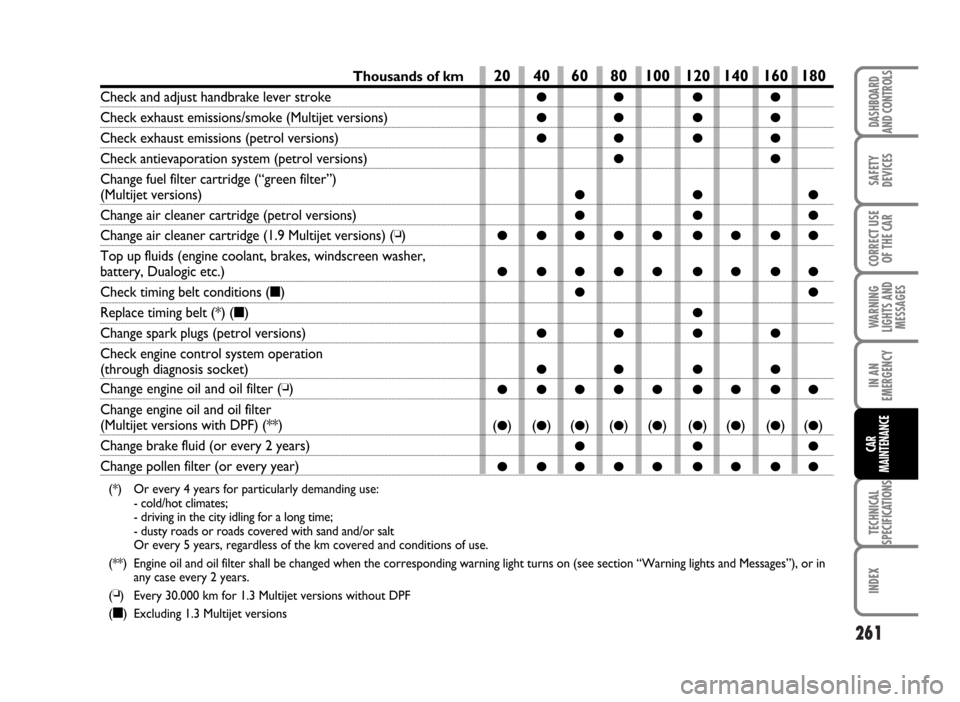
261
SAFETY
DEVICES
CORRECT USE
OF THE CAR
WARNING
LIGHTS AND
MESSAGES
IN AN
EMERGENCY
TECHNICAL
SPECIFICATIONS
INDEX
DASHBOARD
AND CONTROLS
CAR
MAINTENANCE
Thousands of km
Check and adjust handbrake lever stroke
Check exhaust emissions/smoke (Multijet versions)
Check exhaust emissions (petrol versions)
Check antievaporation system (petrol versions)
Change fuel filter cartridge (“green filter”)
(Multijet versions)
Change air cleaner cartridge (petrol versions)
Change air cleaner cartridge (1.9 Multijet versions) (❏)
Top up fluids (engine coolant, brakes, windscreen washer,
battery, Dualogic etc.)
Check timing belt conditions (■)
Replace timing belt (*) (■)
Change spark plugs (petrol versions)
Check engine control system operation
(through diagnosis socket)
Change engine oil and oil filter (❏)
Change engine oil and oil filter
(Multijet versions with DPF) (**)
Change brake fluid (or every 2 years)
Change pollen filter (or every year)
(*) Or every 4 years for particularly demanding use:
- cold/hot climates;
- driving in the city idling for a long time;
- dusty roads or roads covered with sand and/or salt
Or every 5 years, regardless of the km covered and conditions of use.
(**) Engine oil and oil filter shall be changed when the corresponding warning light turns on (see section “Warning lights and Messages”), or in
any case every 2 years.
(
❏) Every 30.000 km for 1.3 Multijet versions without DPF
(
■) Excluding 1.3 Multijet versions
20 40 60 80 100 120 140 160 180
●● ● ●
●● ● ●
●● ● ●
●●
●●●
●●●
●●●●● ●●●●
●●●●● ●●●●
●●
●
●● ● ●
●● ● ●
●●●●● ●●●●
(●)(●)(●)(●)(●)(●)(●)(●)(●)
●●●
●●●●● ●●●●
Page 263 of 314
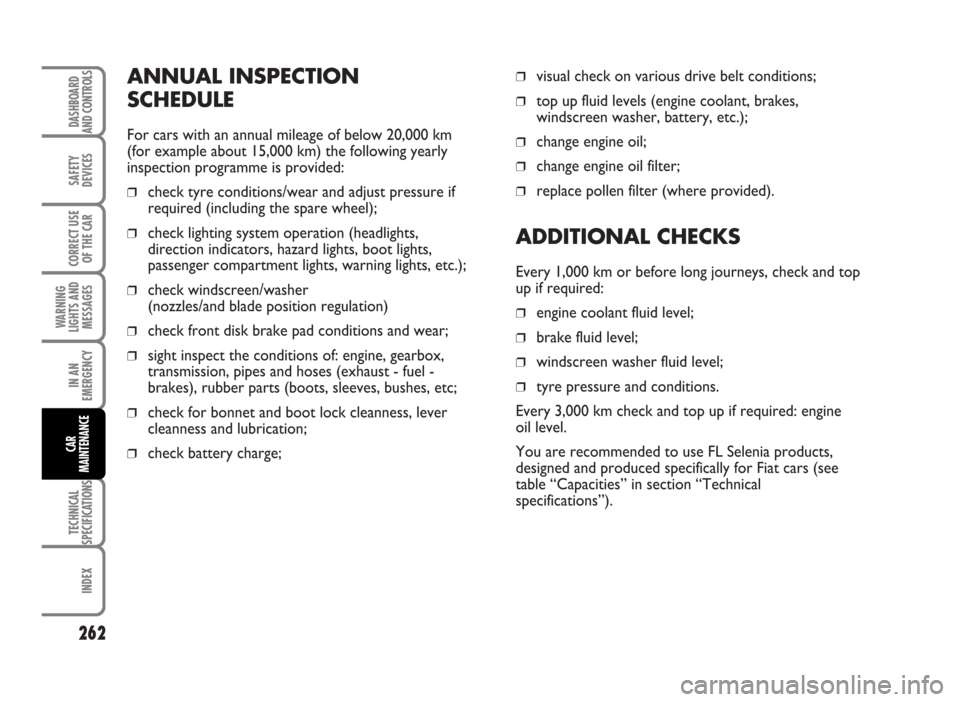
ANNUAL INSPECTION
SCHEDULE
For cars with an annual mileage of below 20,000 km
(for example about 15,000 km) the following yearly
inspection programme is provided:
❒check tyre conditions/wear and adjust pressure if
required (including the spare wheel);
❒check lighting system operation (headlights,
direction indicators, hazard lights, boot lights,
passenger compartment lights, warning lights, etc.);
❒check windscreen/washer
(nozzles/and blade position regulation)
❒check front disk brake pad conditions and wear;
❒sight inspect the conditions of: engine, gearbox,
transmission, pipes and hoses (exhaust - fuel -
brakes), rubber parts (boots, sleeves, bushes, etc;
❒check for bonnet and boot lock cleanness, lever
cleanness and lubrication;
❒check battery charge;
❒visual check on various drive belt conditions;
❒top up fluid levels (engine coolant, brakes,
windscreen washer, battery, etc.);
❒change engine oil;
❒change engine oil filter;
❒replace pollen filter (where provided).
ADDITIONAL CHECKS
Every 1,000 km or before long journeys, check and top
up if required:
❒engine coolant fluid level;
❒brake fluid level;
❒windscreen washer fluid level;
❒tyre pressure and conditions.
Every 3,000 km check and top up if required: engine
oil level.
You are recommended to use FL Selenia products,
designed and produced specifically for Fiat cars (see
table “Capacities” in section “Technical
specifications”).
262
SAFETY
DEVICES
CORRECT USE
OF THE CAR
WARNING
LIGHTS AND
MESSAGES
IN AN
EMERGENCY
TECHNICAL
SPECIFICATIONS
INDEX
DASHBOARD
AND CONTROLS
CAR
MAINTENANCE
Page 264 of 314

IMPORTANT - Engine oil
Should prevailing use of the car be under one of the
following specially heavy conditions:
❒trailer or caravan towing;
❒dusty roads;
❒short distances (less than 7-8 km) repeated and
with external temperatures below zero;
❒frequently idling engines or long distance low speed
driving (e.g. taxis or door-to-door deliveries) or in
case of a long term inactivity;
replace engine oil more frequently than required on
“Service schedule”.
IMPORTANT - Air cleaner
If the car is used on dusty roads change the air cleaner
more frequently than the indications in the “Service
schedule”.
If in doubt as to how often the engine oil and air
cleaner should be changed according to how you use
the car, contact a Fiat Dealership.IMPORTANT - Pollen filter
If the vehicle is used frequently in dusty or heavily
polluted environments it is advisable to replace the
filtering element more frequently; in particular it
should be replaced if a reduction of the amount of air
admitted to the passenger compartment is noted.
IMPORTANT - Diesel filter
The possibility of topping up with diesel fuel not
complying with EN590 European Norm might make it
necessary to replace the filter more frequently than
indicated in the “Service schedule”.
263
SAFETY
DEVICES
CORRECT USE
OF THE CAR
WARNING
LIGHTS AND
MESSAGES
IN AN
EMERGENCY
TECHNICAL
SPECIFICATIONS
INDEX
DASHBOARD
AND CONTROLS
CAR
MAINTENANCE
Page 266 of 314
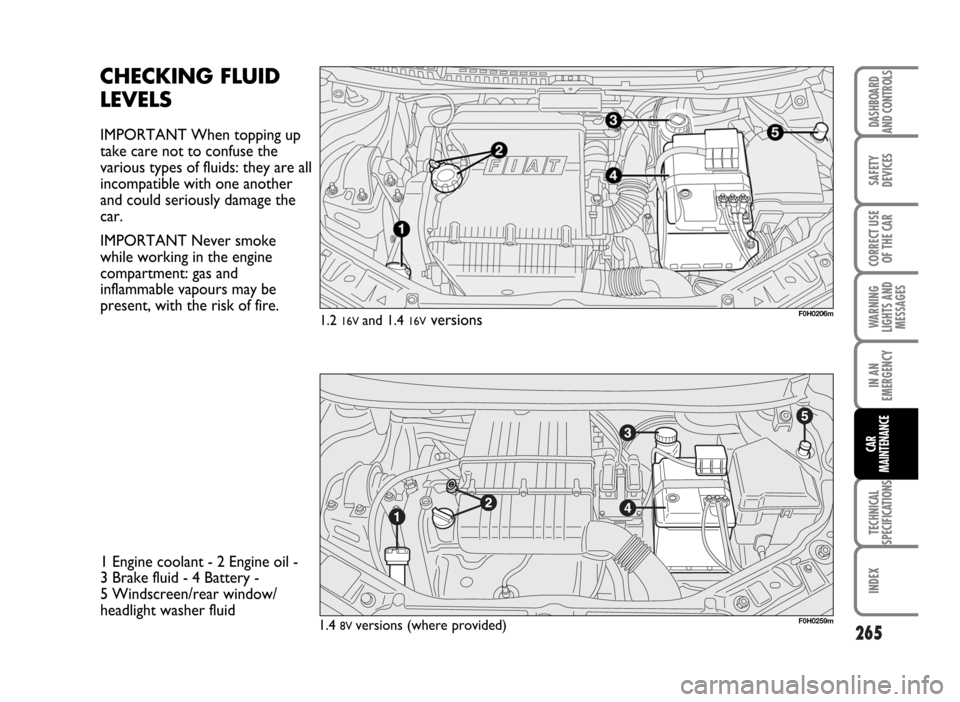
265
SAFETY
DEVICES
CORRECT USE
OF THE CAR
WARNING
LIGHTS AND
MESSAGES
IN AN
EMERGENCY
TECHNICAL
SPECIFICATIONS
INDEX
DASHBOARD
AND CONTROLS
CAR
MAINTENANCE
CHECKING FLUID
LEVELS
IMPORTANT When topping up
take care not to confuse the
various types of fluids: they are all
incompatible with one another
and could seriously damage the
car.
IMPORTANT Never smoke
while working in the engine
compartment: gas and
inflammable vapours may be
present, with the risk of fire.
1 Engine coolant - 2 Engine oil -
3 Brake fluid - 4 Battery -
5 Windscreen/rear window/
headlight washer fluid
F0H0206m1.2 16V and 1.4 16Vversions
F0H0259m1.4 8V versions (where provided)
Page 267 of 314
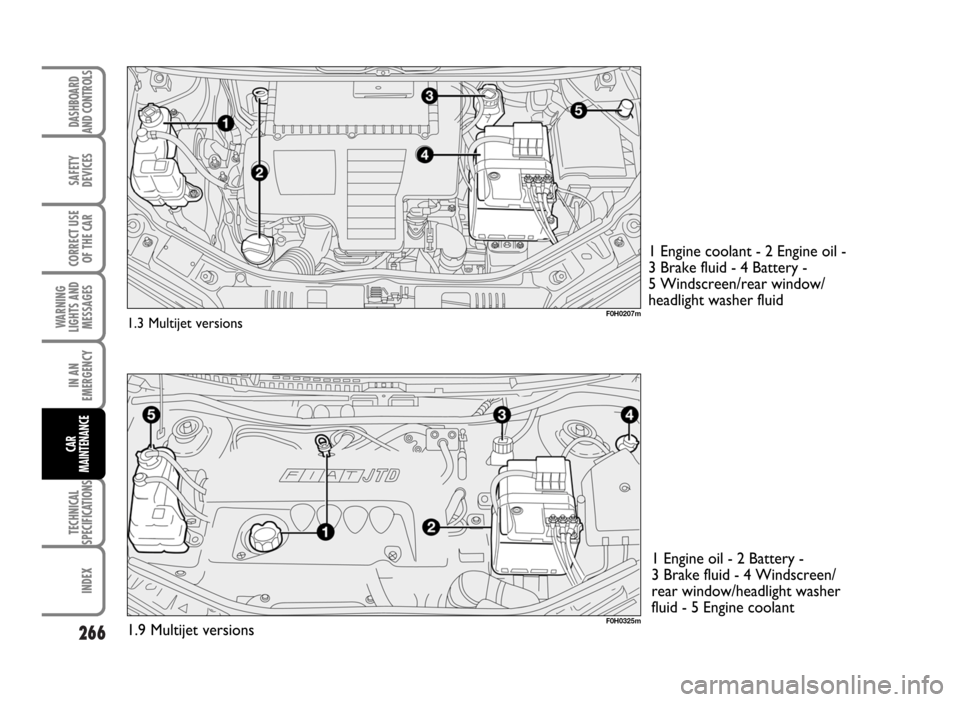
266
SAFETY
DEVICES
CORRECT USE
OF THE CAR
WARNING
LIGHTS AND
MESSAGES
IN AN
EMERGENCY
TECHNICAL
SPECIFICATIONS
INDEX
DASHBOARD
AND CONTROLS
CAR
MAINTENANCE
1 Engine oil - 2 Battery -
3 Brake fluid - 4 Windscreen/
rear window/headlight washer
fluid - 5 Engine coolant
F0H0325m1.9 Multijet versions
F0H0207m1.3 Multijet versions
1 Engine coolant - 2 Engine oil -
3 Brake fluid - 4 Battery -
5 Windscreen/rear window/
headlight washer fluid